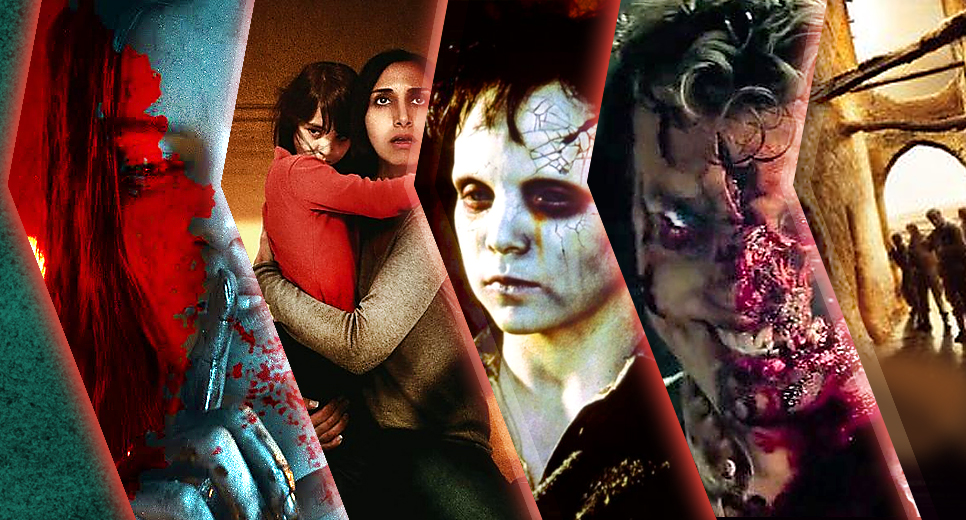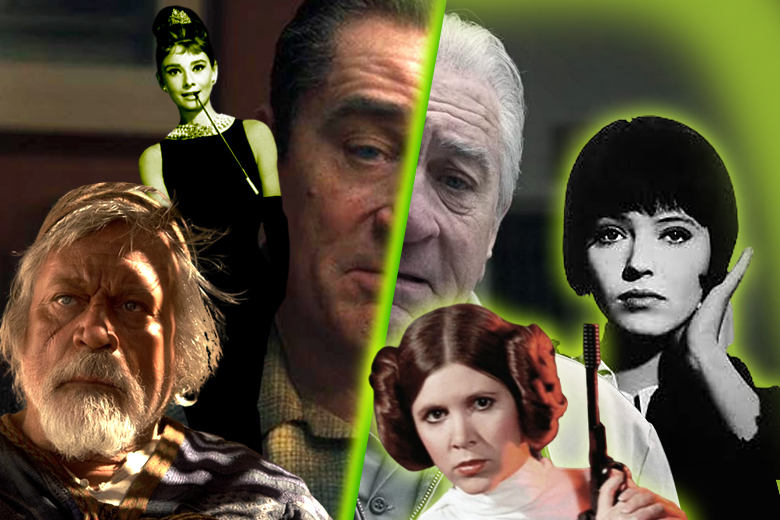Film UA company has announced a lineup of Ukrainian folk horror films, starting with “The Witch of Konotop,” where the mythology of Gogol’s tales intertwines with present-day military realities. While the film is still in production for a 2024 release, we invite you to appreciate its teaser and, at the same time, revisit folk horror movies dedicated to other military conflicts.
Ravenous (1999), directed by Antonia Bird
Set in 1847 during the US-Mexico war for control of Texas, “Ravenous” follows Captain John Boyd (Guy Pearce), a cowardly soldier who pretends to be dead on the battlefield but later seizes the enemy’s headquarters with a sudden burst of courage. For his second act, he receives commendation from his superiors, but for his first act, he is exiled to a fort hidden in the mountains of California. Chaos ensues at the fort when a gaunt traveler named Colqhoun (Robert Carlyle) arrives one night, claiming that his companions are trapped in a cave, starving and resorting to cannibalism. The garrison at the fort is determined to rescue those who may still be alive, but an Indian named George believes that cannibalism has turned them into “wendigos,” perpetually hungry demonic undead beings who feed on human energy. Boyd, who joined the expedition, begins to suspect that his recent act of heroism was a result of the blood of the slain commander that entered his throat. “Ravenous,” partially based on real events, was filmed in Slovakia and Mexico. Despite production challenges—daily script rewrites and three director changes (Milcho Manchevski, Raja Gosnell, Antonia Bird)—the final product is a solid retro horror film with a touch of black humor and an impressive soundtrack. According to the creators and several critics, it also serves as a metaphor for the insatiable conquerors of America, who built a society of consumption on conquered lands.
The Devil’s Backbone (2001), directed by Guillermo del Toro
The first film in Guillermo del Toro’s gothic diptych about the Spanish Civil War, “The Devil’s Backbone,” is set in 1939 when the war is nearing its end, leaving cities in ruins and the rebel Francoist army crushing the remnants of republican resistance. Young Carlos (Fernando Tielve) arrives at an orphanage secluded in the provincial desert, where an unexploded bomb protrudes from the mud in the courtyard. The caretakers of the orphanage, Director Carmen and Dr. Casares (Federico Luppi, Marisa Paredes), are ready to flee the country at any moment. The timid orphans whisper about a ghost whose heavy sighs can be heard at night. However, subsequent events prove that the living, not the dead, are the ones to fear in times of war. Del Toro started developing the script for “The Devil’s Backbone” during his college years, originally centered around a mountain range in Mexico called “El Espinazo del Diablo.” The setting eventually shifted to Spain, but del Toro kept the name, justifying it in a specially written scene that will undoubtedly leave a lasting impression. Fans of folklore monsters will also enjoy del Toro’s later film, “Pan’s Labyrinth” (2006), where otherworldly creatures are terrifying but not as terrifying as the humans who have aligned with evil.
Overlord (2018), directed by Julius Avery
In June 1944, as part of the “Overlord” operation, Allied troops land in Normandy. Several hours before the operation begins, a group of American soldiers infiltrates a French village behind enemy lines. Their mission is to destroy a radio jamming generator located in a tower above a church. However, the church also conceals a secret laboratory where the occultist institute “Ahnenherbe” conducts experiments on the local inhabitants, attempting to turn the “power of the earth” (hint: a certain petroleum component) into a means of resurrecting the dead. Hauptsturmführer Wafner (Pilou Asbæk), an SS officer who predictably stands in the way of the invaders, explains, “The Thousand-Year Reich needs immortal soldiers.” “Overlord” was conceived by American producer J.J. Abrams and brought to life by Australian director Julius Avery. It is a solid B-movie in comic book style, featuring a classic ensemble of characters, including an SS vampire, a diabolical doctor (Erich Redman), and American “goodfellas” ranging from battle-hardened corporal and ruthless killer Lewis Ford (son of Kurt Russell and Goldie Hawn, Wyatt Russell) to compassionate African-American private Ed Boyce (Jovan Adepo), who becomes the film’s main hero. The movie offers a satisfying level of action, makeup effects, and special effects. It confidently presses the genre’s expected buttons, dutifully addresses anti-racist themes, and avoids taking itself too seriously, for which the filmmakers deserve thanks. Fans of alternative history and dark tales about Hitler’s super-soldiers who seek further indulgence can confidently continue their movie night with the Dutch mockumentary “Frankenstein’s Army” (2013).
Djinns (2010), directed by Hugues Martin, Sandra Martin
Set in 1960 during the Algerian War of Independence, a small squad of the French Foreign Legion searches for a missing airplane in the desert. They find only wreckage, with the crew dead, but a case containing important information remains intact. A local partisan attack and a sandstorm force the soldiers to retreat to a village inhabited by Bedouin fellahs, which they must control. This is just the beginning of their misfortunes: soon, the French soldiers begin showing signs of madness, attacking each other, and a local sorceress explains that they have been possessed by desert djinns. “Djinns,” written and directed by debutants Hugues and Sandra Martin, stands out among other war-themed horror films, such as the British “Deathwatch” (2002) and the American “The Bunker” (2022), where the authors struggled to clearly explain the supernatural forces causing the soldiers to hallucinate and turn against each other. In this film, the folkloric demons are not only classified but also have a kind of motivation for their malevolent actions. Throughout the movie, the creators try not to burden the audience with political information and anti-colonial rhetoric. The problems faced by the brave white soldiers are portrayed in a way that makes it hard not to sympathize with them, following the conventions of the war genre. However, if you haven’t studied history diligently in school and know nothing about Algeria, the film’s ending will deliver a sobering blow—a wake-up call that may tempt you to visit Wikipedia.
R-Point (2004), directed by Kong Su-chang
In 1872, during the Vietnam War, a South Korean army radio operator stationed in Nha Trang triangulates a distress call from “R-Point”—a three-kilometer area on an island near Saigon considered sacred by the Vietnamese. Six months ago, a Korean platoon disappeared there without a trace, and the only soldier who managed to return to the base lost his sight and suffered mental trauma. Although he believes all his comrades died, the command sends a rescue squad led by Lieutenant Choi (Kam Woo-sung), a punished officer. It turns out to be a bad idea. The cursed place is strewn with corpses, graves, and vengeful spirits. It plays mind games with Choi and his team, driving them to madness and turning them against each other. After a few days, it becomes clear that they need to leave, but the helicopter is in no hurry to pick them up. After all, the inscription on the stone warned that strangers are not welcome there! South Korean film “R-Point” marked the directorial debut of screenwriter Kong Su-chang (known for adapting his compatriot Ahn Jung-hyo’s acclaimed novel “White Badge” into what some critics consider the best Korean film about the Vietnam War). This is far from the first and definitely not the last horror film about the obvious cursed and insane nature of any war. Such films are produced in Europe and the US every few years. However, everything is relative: the Vietnamese setting and reliance on local mythology give “R-Point” its originality and a unique charm that its Western counterparts lack.
Under the Shadow (2016), directed by Babak Anvari
Set in the mid-1980s during the Iran-Iraq War, Baghdad bombards Tehran with missiles, forcing many residents to flee their homes. Shide, a housewife (Narges Rashidi), watches as her apartment building empties out. A rocket has landed in their apartment but miraculously did not explode, leaving a crack in the ceiling. However, Shide refuses to evacuate with everyone else, despite her husband, calling from the front lines, demanding that they send their daughter, Dorsa, to his parents in the province. She doesn’t want to depend on her mother-in-law. The Tehran apartment becomes her sanctuary from reality and a reminder of life before the Islamic Revolution when she could dream of a medical career without punishment for not wearing a hijab or watching music videos. However, after the rocket strike, her cozy world starts to unravel: Dorsa develops an “imaginary friend” with a sinister character, and Shide begins hearing strange sounds while things go missing or get damaged. She tries to find rational explanations for everything and refuses to listen to her religious neighbor, who believes that an evil djinn has taken up residence in their home, as djinns always seek out places “filled with fear and turmoil.” “Under the Shadow,” a co-production of Qatar, Jordan, and the United Kingdom, marks the directorial debut of Babak Anvari, an Iranian-born filmmaker who experienced the Iran-Iraq War during his childhood, much like the lead actress. Fans of the acclaimed Australian film “The Babadook” (2014) will note similarities in the plot, but they are unlikely to regret spending their time on this film. By placing the familiar metaphorical elements within a complex context, the movie gains new dimensions and depth. Like “The Babadook,” the well-crafted suspense keeps viewers guessing until the end, questioning whether the “paranormal” problems the protagonist faces are a result of stress and psychological disturbance—making the resolution all the more intriguing.
Source: The Gaze







